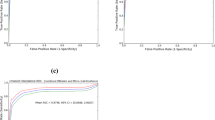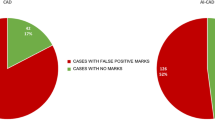Abstract
Purpose
The study compares the diagnostic accuracy (correct identification of cancer) of a new computer-assisted diagnosis (CAD) system (Cyclopus) with two other commercial systems (R2 and CADx).
Materials and methods
Cyclopus was tested on a set of 120 mammograms on which the two compared commercial systems had been previously tested. The set consisted of mammograms reported as negative, preceding 31 interval cancers reviewed as screening error or minimal sign, and of 89 verified negative controls randomly selected from the same screening database.
Results
Cyclopus sensitivity was 74.1% (R2=54.8%; CADx=41.9%) and was higher for interval cancers reviewed as screening error (90.9%; R2=54.5%; CADx=81.8%) compared with those reviewed as minimal sign (65.0%; R2=55.0%; CADx=20.0%). Specificity was 15.7% (R2=29.2%; CADx=17.9%). Overall accuracy was 30.8% (R2=35.8%; CADx=24.1%). The positive predictive value of a case with CAD marks [regions of interest (ROI)] was 23.4% (23/98; R2=16.0%; CADx=15.1%). Average ROI number per view among negative controls was 1.13 (R2=0.93; CADx=0.99). Cyclopus was more sensitive for masses compared with isolated microcalcifications (208 vs 62 ROI; R2=90 vs 213; CADx=192 vs 130).
Conclusions
Compared with two other commercial systems, Cyclopus was more sensitive (R2 p=0.14; CADx p=0.02) and less specific (R2 p=0.02; CADx p=0.64).
Riassunto
Obiettivi
Lo studio confronta l’accuratezza diagnostica (corretta identificazione di neoplasie) di un nuovo sistema CAD (Cyclopus) rispetto a due sistemi CAD commerciali di uso comune, CADx e R2
Materiali e metodi
Cyclopus è stato testato su un set di 120 mammografie sul quale erano precedentemente stati testati i due sistemi commerciali a confronto. Il set contiene 31 mammografie di screening refertate come negative, precedenti la comparsa di carcinomi di intervallo classificati alla revisione come errori di screening o minimal sign, e 89 controlli negativi verificati, scelti a random dalla stessa casistica di screening.
Risultati
La sensibilità di Cyclopus è stata del 74,3% (R2=54,8%; CADx=41,9%), ed è risultata più elevata per i carcinomi di intervallo classificati come errore di screening (90,9%; R2=54,5%; CADx=81,8%) che per quelli classificati come minimal sign (65,0%; R2=55,0%; CADx=20,0%). La specificità è risultata del 15,7% (R2=29,2%; CADx=17,9%). L’accuratezza complessiva è stata del 30,8% (R2=35,8%; CADx=24,1%). Il valore predittivo positivo di un caso con marcatura (ROI) è stato del 23,4% (23/98; R2=16,0%; CADx=15,1%). Il numero medio di ROI per proiezione tra i controlli negativi è risultato essere di 1,13 (R2=0,93; CADx=0,99). Cyclopus è risultato assai più sensibile per la presenza di opacità di massa che per microcalcificazioni (208 vs 62 ROI; R2=90 vs 213; CADx=192 vs130).
Conclusioni
Rispetto ai due sistemi CAD a confronto Cyclopus risulta più sensibile (R2 p=0,14; CADxp=0,02), e meno specifico (R2 p=0,02; CADxp=0,64).
Similar content being viewed by others
References/Bibliografia
Bennett RL, Blanks RG, Moss SM (2006) Does the accuracy of single reading with CAD (computer-aided detection) compare with that of double reading?: a review of the literature. Clin Radiol 61:1023–1028
Taylor P, Potts HWW (2008) Computer aids and human second reading as interventions in screening mammography: Two systematic reviews to compare effects on cancer detection and recall rate. Eur J Cancer 44:798–807
Fenton JJ, Taplin SH, Carney PA et al (2007) Influence of computer-aided detection on performance of screening mammography. N Engl J Med 356:1399–1409
Ciatto S, Rosselli Del Turco M, Risso G et al (2003) Comparison of standard reading and computer aided diagnosis (CAD) on a national proficiency test of screening mammography. Eur J Radiol 45:135–138
Ciatto S, Brancato B, Rosselli Del Turco M et al (2003) Comparison of standard reading and computer aided diagnosis (CAD) on a proficiency test of screening mammography. Radiol Med 106:59–65
Freer TW, Ulissey MJ (2001) Screening mammography with computer-aided detection: prospective study of 12,860 patients in a community breast center. Radiology 220:781–786
Helvie MA, Hadjiiski L, Makariou E et al (2004) Sensitivity of noncommercial computer-aided detection system for mammographic breast cancer detection: pilot clinical trial. Radiology 231:208–214
Ciatto S, Ambrogetti D, Bonardi R et al (2004) Comparison of two commercial systems for computer aided detection (CAD) as an aid to interpreting screening mammograms. Radiol Med 107:480–488
Paci E, Crocetti E, Miccinesi G et al (eds) (2002) Cancer incidence in five continents, vol. VIII. IARC Scientific Publications n. 155, Lyon
Perry NM, Broeders M, de Wolf C et al (2006) European guidelines for quality assurance in breast cancer screening and diagnosis. European Commission, Luxembourg
Cascio D, Fauci F, Magro R, Raso G (2007) Method for processing biomedical images. PCT/IB2007/051282. MEDICAD srl., 2007
Houssami N, Irwig L, Ciatto S (2006) Radiological surveillance of interval breast cancers in screening programmes. Lancet Oncol 7:259–265
Gabe R, Duffy SW (2005) Evaluation of service screening mammography in practice: the impact on breast cancer mortality. Annals Oncology 16:153–162
Roder DM, Houssami N, Farshid G et al (2008) Population screening and intensity of screening are associated with reduced breast cancer mortality: evidence of efficacy of mammography screening in Australia. Breast Cancer Res Treat 108:409–416
Ciatto S, Del Turco MR, Morrone D et al (1995) Independent double reading of screening mammograms. J Med Screen 2:99–101
Blanks RG, Wallis MG, Moss SM (1998) A comparison of cancer detection rates achieved by breast cancer screening programmes by number of readers, for one and two view mammography: results from the UK National Health Service breast screening programme. J Med Screen 5:195–201
Gur D, Sumkin JH, Rockette HE et al (2004) Changes in breast cancer detection and mammography recall rates after the introduction of a computer-aided detection system. J Natl Cancer Inst 96:185–190
Khoo LA, Taylor P, Given-Wilson RM (2005) Computer-aided detection in the United Kingdom National Breast Screening Programme: prospective study. Radiology 237:444–449
Birdwell RL, Bandodkar P, Ikeda DM (2005) Computer-aided detection with screening mammography in a university hospital setting. Radiology 236:451–457
Cupples TE, Cunningham JE, Reynolds JC (2005) Impact of computer-aided detection in a regional screening mammography program. AJR Am J Roentgenol 185:944–950
Ko JM, Nicholas MJ, Mendel JB, Slanetz PJ (2006) Prospective assessment of computer-aided detection in interpretation of screening mammography. AJR Am J Roentgenol 187:1483–1491
Morton MJ, Whaley DH, Brandt KR, Amrami KK (2006) Screening mammograms: interpretation with computer-aided detection — prospective evaluation. Radiology 239:375–383
Ciatto S, Rosselli Del Turco M, Zappa M (1995) The detectability of breast cancer by screening mammography. Br J Cancer 71:337–339
Author information
Authors and Affiliations
Corresponding author
Rights and permissions
About this article
Cite this article
Ciatto, S., Cascio, D., Fauci, F. et al. Computer-assisted diagnosis (CAD) in mammography: comparison of diagnostic accuracy of a new algorithm (Cyclopus®, Medicad) with two commercial systems. Radiol med 114, 626–635 (2009). https://doi.org/10.1007/s11547-009-0396-4
Received:
Accepted:
Published:
Issue Date:
DOI: https://doi.org/10.1007/s11547-009-0396-4




